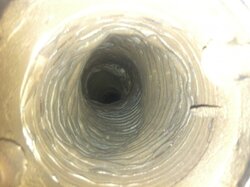New liner last fall, 6" stainless smooth bore flex with 1/2" insulation. Went through about 5.5 cords of dry wood. Go to clean my chimney and I see this and I am just flabbergasted. It looks like it has been partially melted and all the seams are seperating. That is insulation you see in the seam that has fully seperated up the pipe a little bit. How does this happen? Did I somehow manage to put it in upside down?
Pic is from the stove side.
Zero black creosote anywhere. Just white ash and this brown fluffy stuff
Pic is from the stove side.
Zero black creosote anywhere. Just white ash and this brown fluffy stuff


